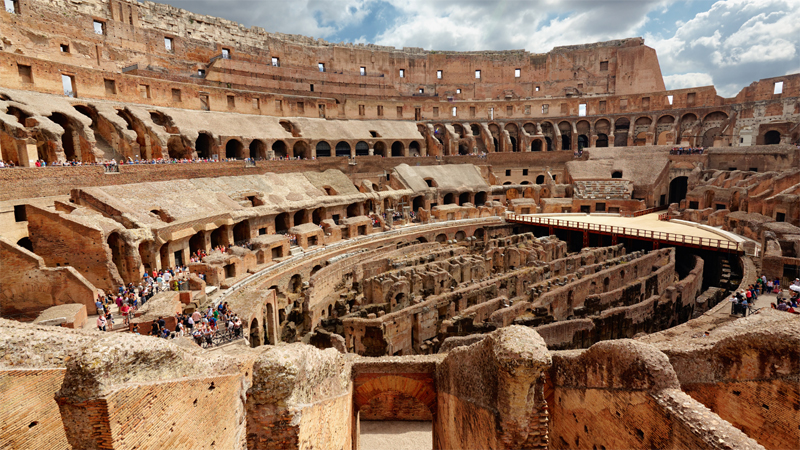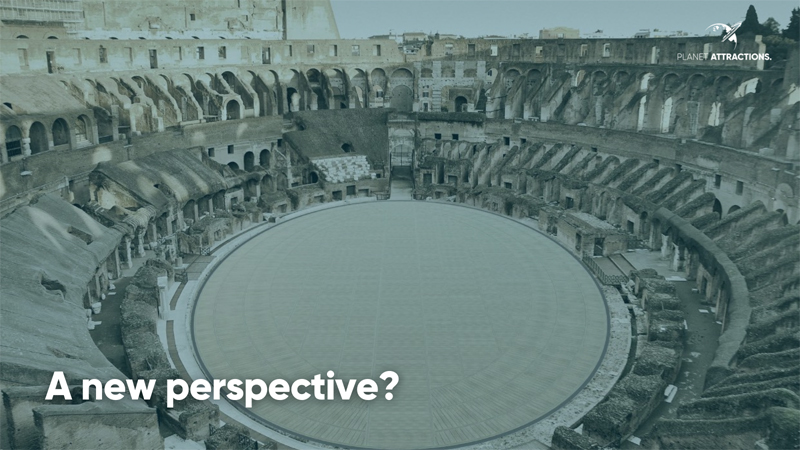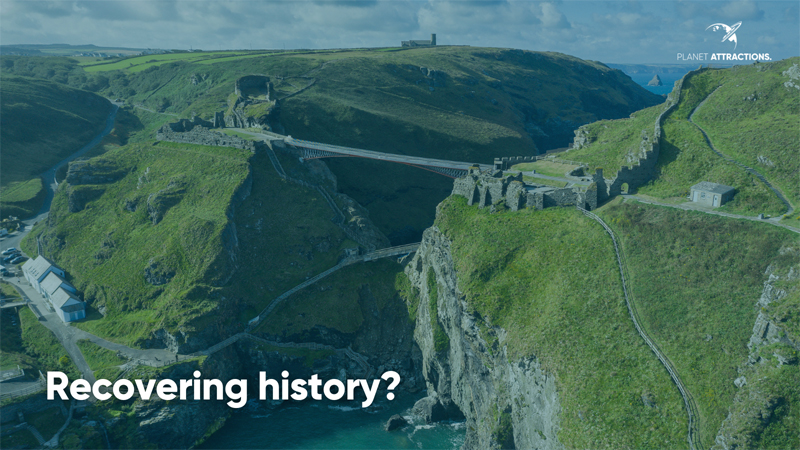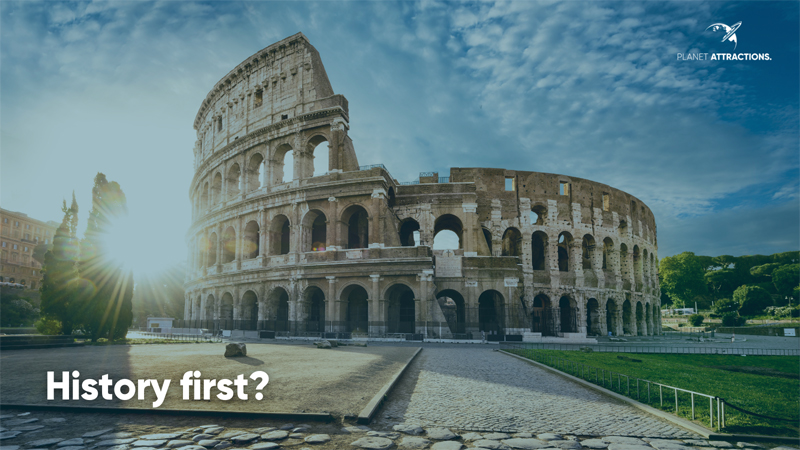|
Where exactly is the line when it comes to improving the visitor experience and interfering with historic sites?

Tom Anstey | Planet Attractions | 25 May 2021

 The Colosseum’s hypogeum will be covered up by a new floor if the plans go ahead Credit: Canva The Colosseum’s hypogeum will be covered up by a new floor if the plans go ahead Credit: Canva
In the final days of the year that was 2020, Italy’s Ministry of Culture announced plans to spend €18.5m (US$22.4m, £16m) on a major new heritage project, something that was almost certain to bring back tourists lost as a result of the global pandemic.
On May 2, the winning design, which is part of the government’s wider strategy to restore and reorganise Rome’s historical sites, was unveiled to huge fanfare.
All sounds great right? Well not quite.

The project in question would see the Colosseum, arguably Italy’s most iconic heritage site, receive a retractable wooden floor, offering visitors the chance to stand where Rome’s gladiators once stood and take in this piece of Roman history from an entirely new perspective. The addition of the floor would also open up the Colosseum for use in major culture events, which culture minister Dario Franceschini has promised will be “of the highest quality”.
The original Colosseum of course had a floor, which survived in various iterations as late as the 1930s, when Mussolini ordered archaeological excavations to clear the earth that replaced the floor for good.The original floor was destroyed in 217 AD when a fire started by lightning destroyed much of it. The site has a tangled history however with many modifications taking place over nearly 400 years of continuous use, so it’s not entirely certain what survived until when.
Milanese firm Ingegneria has been handed the task of installing the modern wooden floor above the hypogeum - a historic wooden structure covering 3,000sq m, whose layout tells the history of the corridors below the floor.
For the first time in modern history, people will be able to experience in real life the layout of the Colosseum, with the floor also giving them a better idea of what it must have been like to be held in the dark hypogeum underneath.
In non-pandemic times, around seven million people visit the Colosseum each year. With the addition of a floor, this number could rise significantly but not everyone thinks this is a good thing. The project received criticism, with some commentators questioning the large price tag and asking simply whether the venue needs a floor at all.

In addition to cost, critics opposing the project have highlighted a number of concerns.
The first is potential damage to the ruins, though Ingegneria says the installation will place heritage preservation at its forefront, with the construction of the floor completely reversible with no damage caused to the remains.
The second point raised concerns the obscuring of the hypogeum, which is seen as a key aspect of the current Colosseum experience.
The third, and perhaps the most important aspect, is the further commercialisation of a site which is already a key part of tourism not only in Rome but for all of Italy. Opponents to the plans say that commercial concerns (high-paying sponsors for example) and upkeep costs mean archeological issues might come face-to-face with commercial ones. If it means funding, it’s likely, believe critics, that the commercial concerns will win out.

Commercialism for a heritage site however isn’t necessarily a bad thing. Look at the Merlin Entertainments-operated Warwick Castle in the UK.
A medieval castle developed from a wooden fort and originally built by William the Conqueror in 1068, Warwick Castle is an iconic piece of British history but also one that has been turned into a fully-fledged attraction that goes way beyond the traditional castle experience.
Originally purchased by the Tussauds Group in 1978, Merlin acquired the property following a merger in 2007, which was then sold to the Prestbury Group under a sale and leaseback agreement, renewable every 35 years.
The castle is still protected against unauthorised change as a Scheduled Ancient Monument and is a Grade I listed building. However, Merlin has taken that heritage and made it into a spectacle that even the non-history buff will enjoy.
In 2005, the castle became home to one of the world's largest working siege engines - an 18m (59ft) -tall trebuchet, which draws huge crowds wanting to see it fired.
Taking in the best of Merlin’s many attractions, the castle itself is filled with historical waxworks courtesy of Tussauds, while part of the castle has also been converted into a Dungeons experience. Other tourist attractions include a bird show featuring eagles and vultures, archery displays and jousting.
A visit to Warwick Castle isn’t quite a step back in time thanks to the huge amounts of visitors around you but it certainly is an ‘attractified’ window into the past, bringing history to life in the most exciting and engaging way possible.
For Warwick, this approach is clearly working. With an average pre-Covid attendance of around 625,000 visitors a year, Warwick Castle is among the top 20 attractions anywhere in Britain.

Staying in the UK, in August 2019, English Heritage finished a landmark project reconnecting the divided landscape of Tintagel - the inspiration for the legendary King Arthur.
In the Middle Ages, Tintagel's residents walked from one side of the site to the other using a narrow land bridge as high as the clifftops. But the crossing disappeared somewhere between the 14th and 17th centuries, leaving a natural chasm between the 13th century castle and the mainland, with the only way to access the historic remains via a very long and narrow set of 140 steps.
The new Tintagel Bridge reinstates the original route, offering visitors the chance to experience Tintagel Castle the way its medieval inhabitants once did. The aim, says English Heritage, was to find a bridge specifically tailored to the castle, harmonising with the iconic coastal landscape. The design sees two cantilevers reach out and meet, not quite touching, with a 40mm gap in the middle, which represents the transition from the mainland to the island, present to past.
Much like the Colosseum, the £5m (US$7m, €5.8m) project received some criticism, with some accusing English Heritage of the “Disneyfication” of the historic site (though it has gone nowhere near levels Warwick Castle has), pointing to a carving of Merlin's head and an Arthurian sculpture as evidence of this.

While this might be the critics’ opinion, it’s undeniable that access to the castle is now significantly easier and available in a much more elegant fashion. Tintagel encourages people to engage in history and whether people like it or not, so will building a floor in the Colosseum.
Of course we should always be mindful of our heritage and must ensure we do everything we can for their protection for future generations. But we also have to consider - what is the point of protecting these historic treasures if no one wants to see them in the first place.
Attractifying Warwick Castle was a game changer for the site, which has sparked the imaginations of countless children wanting to learn more about history.
Building a bridge to Tintagel and leaning into the legend of King Arthur, has had a dramatic impact on footfall to the site, opening it up for people who simply wouldn’t have been able to visit before.
Let’s turn our heads to Rome and to the Colosseum and look at it from that perspective. You might be able to see a downside, but all I can see is the potential that this historic venue offers not only to Italy, but to the countless people that will be inspired as they stand in the centre of that landmark, taking in the awe-inspiring sight that is Rome’s mighty Colosseum.

Heritage
|
|






Supplier Showcase 2025: The biggest attractions projects landing worldwide this year
|